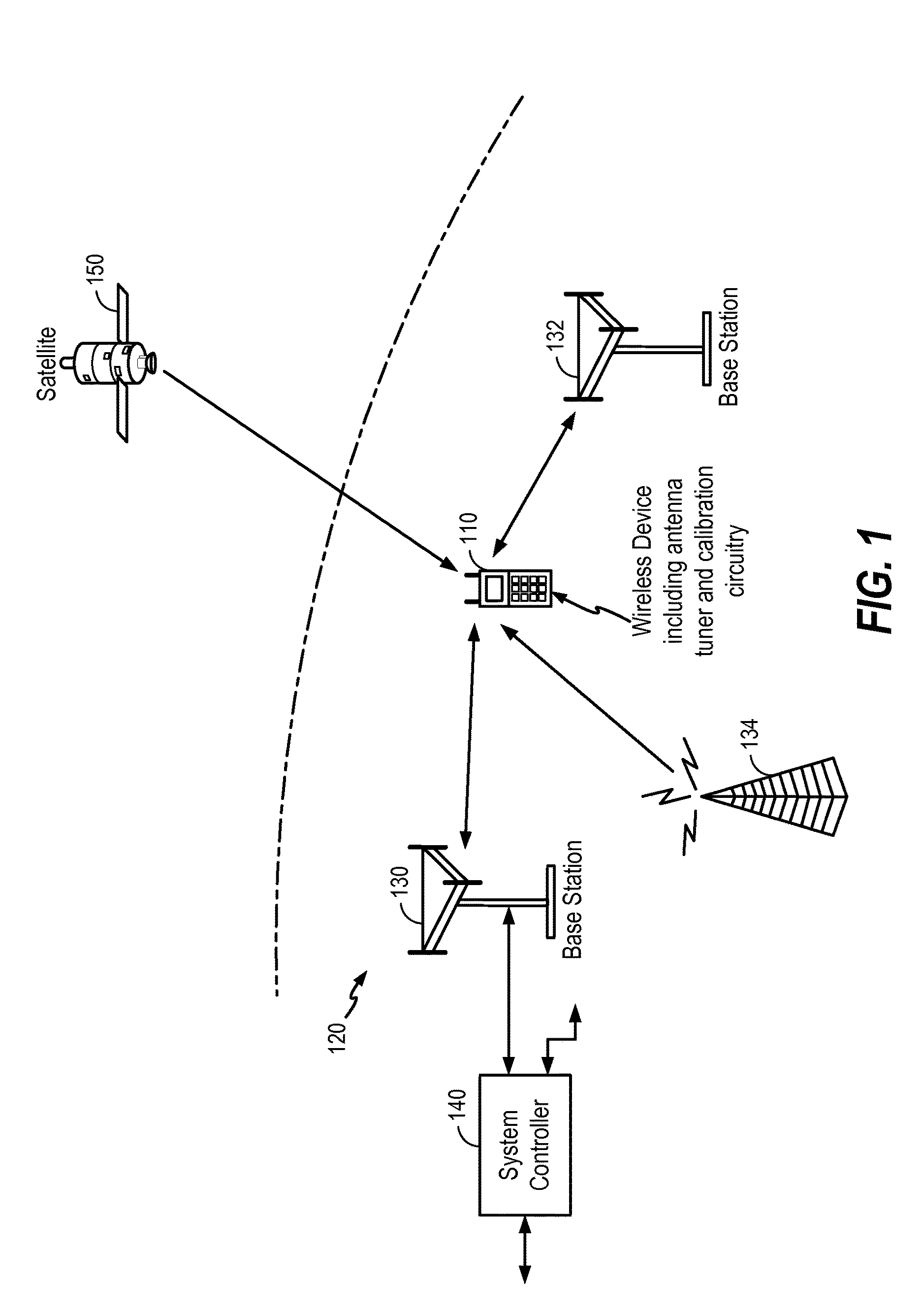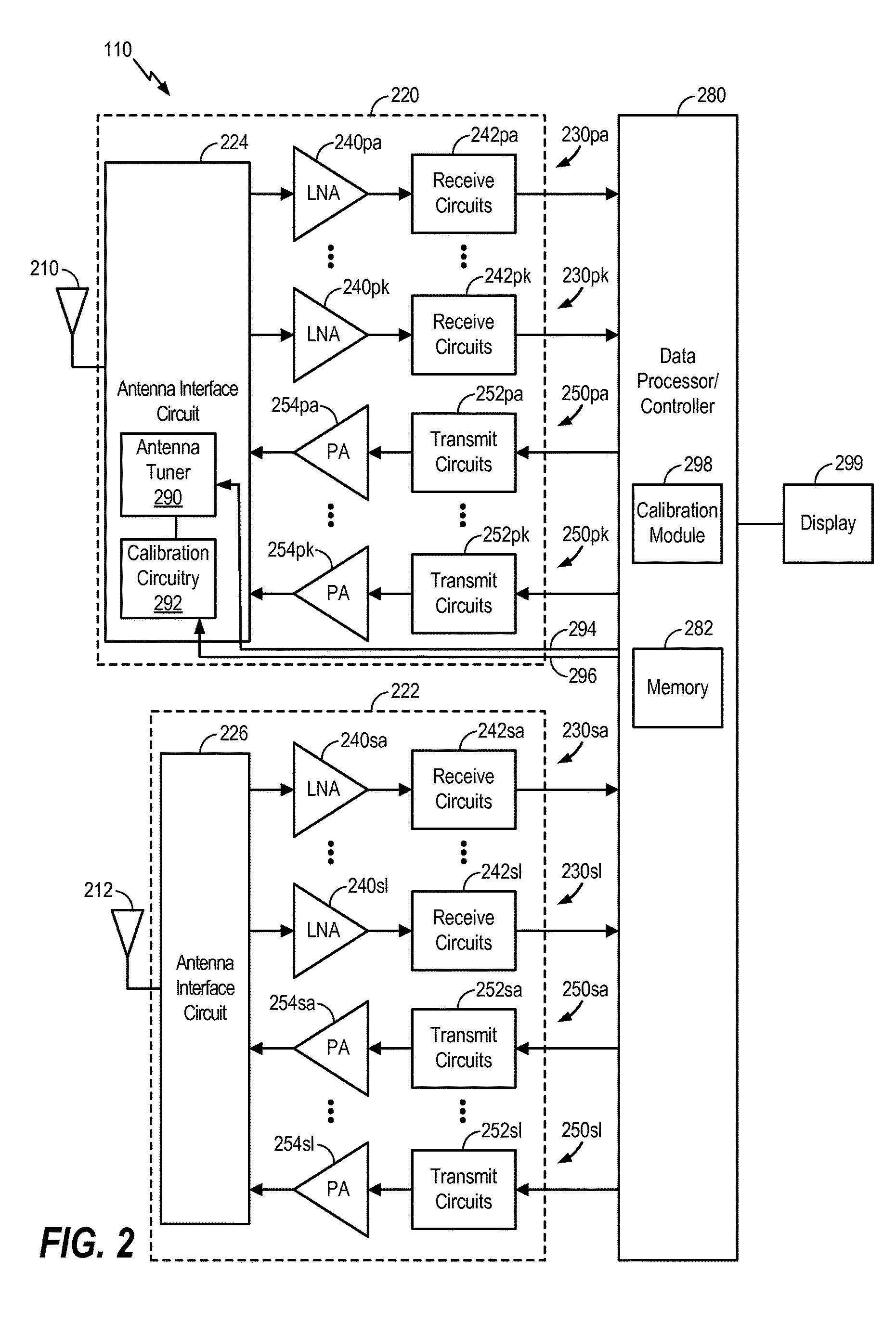Calibration and adaptive control of antenna tuners
a technology of adaptive control and antenna tuners, applied in the field of electrical equipment, can solve the problems of rf communication being adversely affected, adaptive tuning algorithms may have a slow convergence in selecting a tuner setting, and may fail to converg
- Summary
- Abstract
- Description
- Claims
- Application Information
AI Technical Summary
Benefits of technology
Problems solved by technology
Method used
Image
Examples
exemplary embodiment 302
[0027]The first exemplary embodiment 302 illustrates that an output of the antenna tuner 290, the calibration circuitry 292, and the antenna 210 are coupled to the antenna port 324 along an RF path 316, such as a transmission path. A detector 322 may be coupled to the RF path 316 to measure signal properties on the RF path 316 during calibration operations and / or during “normal” (e.g., non-calibration) operations. For example, the RF path 316 may correspond to components of the transceiver 220 (e.g., transmission lines, electrical connections, circuit components, etc.) between the output of the power amplifier 254pa and the input of the antenna 210.
[0028]The tuner 290 is responsive to one or more of the antenna tuner control signals 294 to enable or disable one or more components of the antenna tuner 290 and / or to select a setting of one or more variable impedance components 340 of the antenna tuner 290. An exemplary embodiment of components that may be included in the antenna tuner...
exemplary embodiment 304
[0034]In the second exemplary embodiment 304, the calibration circuitry 292 is at the input to the antenna tuner 290, and the antenna tuner 290 is not part of the RF path to characterize by calibration. In some implementations, the antenna tuner 290 and the antenna 210 are isolated from a component of the RF path 316, such as when the control circuitry 292 decouples an input of the antenna tuner 290 from the RF path 316 (e.g., as described in further detail with respect to FIG. 8). In other implementations, the antenna tuner 290 may be set to a high impedance state to have reduced influence (or no influence) on calibration accuracy or may be set to a predetermined setting that has a “known” influence on the calibration loads. In some implementations, one or more particular settings (e.g., a “known” configuration) of the antenna tuner 290 may be used to set one or more terminating loads of the RF path 316 during calibration.
exemplary embodiment 306
[0035]The third exemplary embodiment 306 illustrates the calibration circuitry 292 included in the antenna tuner 290. For example, the calibration circuitry 292 may be configured to selectively isolate the antenna 210 from a component of the RF path 316 (e.g., from a transmitter, such as the transmitter 250pa of FIG. 2) and may include one or more impedance components and / or switching components that may be configured to bypass or to supplement an impedance of one or more components of the antenna tuner 290. The calibration circuitry 292 may be configured to re-purpose one or more components of the antenna tuner 290 during calibration, such as one or more electrostatic discharge devices (ESDs) of the antenna tuner 290, as described in further detail with respect to FIGS. 7-9.
[0036]Although FIG. 3 depicts three different locations of the calibration circuitry 292 relative to the antenna tuner 290, in other implementations components of the calibration circuitry 292 may be in multiple...
PUM
 Login to View More
Login to View More Abstract
Description
Claims
Application Information
 Login to View More
Login to View More - R&D
- Intellectual Property
- Life Sciences
- Materials
- Tech Scout
- Unparalleled Data Quality
- Higher Quality Content
- 60% Fewer Hallucinations
Browse by: Latest US Patents, China's latest patents, Technical Efficacy Thesaurus, Application Domain, Technology Topic, Popular Technical Reports.
© 2025 PatSnap. All rights reserved.Legal|Privacy policy|Modern Slavery Act Transparency Statement|Sitemap|About US| Contact US: help@patsnap.com



